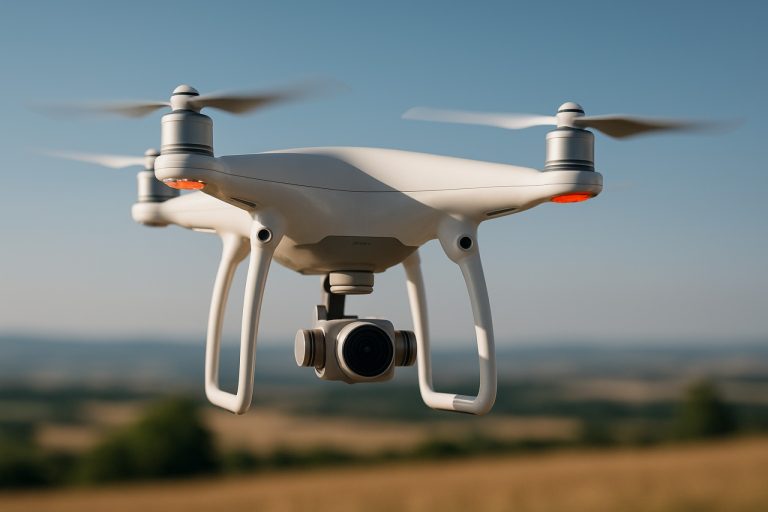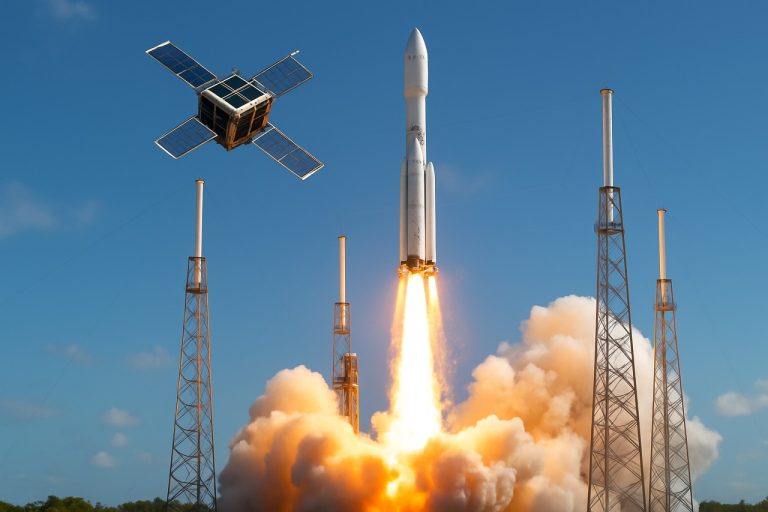
Blasting Ahead: How Smallsat Launch Services Are Transforming the Space Economy
- Market Overview
- Emerging Technology Trends
- Competitive Landscape Analysis
- Growth Projections and Forecasts
- Regional Market Dynamics
- Vision for the Future
- Key Challenges and Emerging Opportunities
- Sources & References
“In summary, the 2025–2032 period will likely be remembered as the “gold rush” era for small satellite launch services, marked by fierce competition, rapidly advancing technology, and multiplying launch opportunities worldwide.” (source)
Market Overview
The global small satellite (smallsat) launch services market is on the cusp of unprecedented growth, driven by surging demand for satellite-based connectivity, Earth observation, and defense applications. Between 2025 and 2032, the market is projected to expand at a compound annual growth rate (CAGR) exceeding 15%, with revenues expected to surpass USD 13 billion by 2032.
Key factors fueling this growth include:
- Proliferation of Constellations: Mega-constellations from companies like SpaceX (Starlink), OneWeb, and Amazon Kuiper are driving demand for frequent, cost-effective launches.
- Technological Advancements: Innovations in miniaturization, propulsion, and modular satellite design are enabling more payloads per launch and reducing costs.
- Emergence of Dedicated Smallsat Launchers: Companies such as Rocket Lab, Virgin Orbit, and Astra are offering tailored services for small payloads, increasing launch cadence and flexibility.
- Government and Defense Initiatives: National security and Earth monitoring programs are increasingly relying on smallsats for rapid deployment and resilience, as seen in the U.S. Space Development Agency’s Tranche 0 launches.
Regionally, North America leads the market, accounting for over 40% of global launches, followed by Europe and Asia-Pacific. The Asia-Pacific region is expected to witness the fastest growth, propelled by investments from China, India, and Japan (GlobeNewswire).
Despite the optimistic outlook, the market faces challenges such as launch bottlenecks, regulatory hurdles, and orbital debris concerns. However, ongoing investments in reusable launch vehicles and rideshare programs are expected to alleviate some of these constraints, ensuring that the smallsat launch services sector remains a dynamic and rapidly evolving frontier through 2032.
Emerging Technology Trends
The small satellite (smallsat) launch services market is poised for explosive growth between 2025 and 2032, driven by surging demand for affordable, flexible, and rapid access to space. Smallsats—typically defined as satellites weighing less than 500 kg—are revolutionizing sectors such as Earth observation, telecommunications, and scientific research. Their proliferation is fueling a new era of commercial space activity, with launch providers racing to meet the needs of a diverse and expanding customer base.
- Market Growth Projections: The global smallsat launch services market is projected to grow from USD 7.7 billion in 2024 to USD 20.7 billion by 2030, at a CAGR of 17.9%. This trajectory is expected to continue through 2032, as satellite constellations for broadband internet, IoT, and remote sensing multiply.
- Key Drivers: The rise of mega-constellations—such as SpaceX’s Starlink and OneWeb—demands frequent, cost-effective launches. Additionally, government initiatives, defense modernization, and the miniaturization of satellite technology are accelerating market expansion (GlobeNewswire).
- Launch Innovations: Dedicated smallsat launchers like Rocket Lab’s Electron, Firefly Alpha, and Virgin Orbit’s LauncherOne are reshaping the industry with rapid turnaround times and tailored orbits. Rideshare missions—where multiple smallsats share a single rocket—are also gaining traction, exemplified by SpaceX’s Transporter missions (SpaceNews).
- Regional Dynamics: North America leads the market, but Europe, Asia-Pacific, and emerging players in the Middle East and Africa are investing heavily in launch infrastructure and indigenous capabilities (Euroconsult).
- Challenges and Opportunities: While regulatory hurdles, launch bottlenecks, and space debris concerns persist, advancements in reusable rockets, in-orbit servicing, and AI-driven mission planning promise to unlock new efficiencies and business models.
As the smallsat launch ecosystem matures, competition and innovation are expected to drive down costs and open space to a broader array of commercial, governmental, and academic users. The coming decade will likely see smallsat launch services become a cornerstone of the global space economy.
Competitive Landscape Analysis
The small satellite (smallsat) launch services market is poised for explosive growth between 2025 and 2032, driven by surging demand for affordable, flexible, and rapid access to space. As the commercial, governmental, and defense sectors increasingly deploy constellations of smallsats for Earth observation, communications, and scientific research, the competitive landscape is intensifying with both established players and innovative startups vying for market share.
- Market Growth and Projections: The global smallsat launch services market is projected to grow at a CAGR of over 15% from 2025 to 2032, reaching an estimated value of USD 13.7 billion by 2032. This surge is fueled by the proliferation of mega-constellations, such as SpaceX’s Starlink and Amazon’s Project Kuiper, and the increasing adoption of smallsats for IoT, remote sensing, and defense applications.
- Key Players and Strategies: The competitive landscape features a mix of legacy launch providers and agile newcomers. SpaceX dominates with its rideshare program, offering cost-effective launches for multiple smallsats on Falcon 9. Rocket Lab has carved a niche with its Electron rocket, specializing in dedicated smallsat launches. Other notable entrants include Virgin Orbit, Astra, and Firefly Aerospace, all focusing on rapid, flexible, and lower-cost launch solutions.
- Emerging Regional Players: The market is witnessing increased participation from Asia-Pacific and Europe. Companies like ISRO (India), GK Launch Services (Russia), and Arianespace (Europe) are expanding their smallsat launch offerings, intensifying global competition and driving down costs.
- Innovation and Differentiation: Competitive differentiation is increasingly based on launch frequency, payload flexibility, and end-to-end mission services. Companies are investing in reusable launch vehicles, vertical integration, and digital platforms for streamlined booking and mission management. For example, SpaceX’s online rideshare portal enables customers to book launches with unprecedented ease.
As the smallsat launch services market rockets into the future, competition will center on reliability, cost, and service innovation. The next decade will likely see further consolidation, new alliances, and the emergence of regional champions, all vying to capture a share of this rapidly expanding market.
Growth Projections and Forecasts
The small satellite (smallsat) launch services market is poised for explosive growth between 2025 and 2032, driven by surging demand for satellite-based connectivity, Earth observation, and defense applications. According to a recent report by MarketsandMarkets, the global small satellite market is projected to grow from $7.7 billion in 2023 to $13.7 billion by 2028, at a CAGR of 11.8%. This robust expansion is mirrored in the launch services sector, which is expected to see even higher growth rates as deployment of smallsat constellations accelerates.
Key drivers include:
- Proliferation of LEO Constellations: Companies like SpaceX, OneWeb, and Amazon’s Project Kuiper are planning to launch thousands of smallsats for broadband internet, fueling demand for frequent, cost-effective launches (SpaceNews).
- Technological Advancements: Innovations in miniaturization, propulsion, and rideshare launch models are reducing costs and increasing launch cadence (NASA Small Spacecraft Systems Virtual Institute).
- Government and Defense Initiatives: National security and Earth observation programs are increasingly relying on smallsat platforms, with agencies like the U.S. Space Force and ESA investing in rapid deployment capabilities (Defense News).
Forecasts suggest the number of smallsat launches will rise dramatically. Euroconsult projects over 18,500 smallsats (under 500 kg) will be launched between 2023 and 2032, a fourfold increase over the previous decade. The annual launch rate is expected to surpass 2,000 smallsats by 2030, with commercial operators accounting for over 80% of demand.
Regionally, North America will maintain its lead, but Asia-Pacific and Europe are rapidly expanding their launch capabilities, with new entrants like India’s Skyroot and South Korea’s INNOSPACE joining established players (SpaceTech Asia).
In summary, the smallsat launch services market is set to skyrocket through 2032, propelled by commercial mega-constellations, technological innovation, and growing government investment. This dynamic sector will be a key enabler of the new space economy, offering unprecedented opportunities for launch providers and satellite operators alike.
Regional Market Dynamics
The global small satellite (smallsat) launch services market is poised for unprecedented growth between 2025 and 2032, driven by surging demand for affordable, flexible, and rapid access to space. As governments, commercial entities, and research organizations increasingly turn to smallsats for Earth observation, communications, and scientific missions, launch providers are racing to expand capacity and lower costs.
North America remains the dominant region, accounting for over 40% of the global smallsat launch market in 2023, thanks to established players like SpaceX, Rocket Lab, and emerging startups such as Astra and Firefly Aerospace (MarketsandMarkets). The U.S. government’s continued investment in defense and intelligence satellites, alongside NASA’s support for commercial launch initiatives, is expected to sustain robust growth through 2032.
Europe is rapidly catching up, with the European Space Agency (ESA) and private companies like Arianespace and Isar Aerospace expanding dedicated smallsat launch services. The region’s market is projected to grow at a CAGR of 18% from 2025 to 2032, fueled by increased funding for space innovation and the EU’s focus on strategic autonomy (GlobeNewswire).
Asia-Pacific is emerging as a powerhouse, with China and India leading the charge. China’s state-backed and private launch providers, such as CASC and iSpace, are scaling up to meet domestic and international demand. India’s ISRO and new entrants like Skyroot Aerospace are also expanding their launch portfolios. The region is forecast to witness the fastest growth, with a CAGR exceeding 20% through 2032 (Fortune Business Insights).
Rest of the World regions, including Latin America and the Middle East, are making strategic investments in launch infrastructure and satellite technology, though their market share remains modest. However, partnerships with established launch providers and government-backed initiatives are expected to gradually boost their presence in the global market.
Overall, the smallsat launch services market is set to skyrocket, with global revenues projected to surpass $13.7 billion by 2032, up from $5.3 billion in 2023 (GlobeNewswire). Regional competition, technological innovation, and new business models will continue to reshape the industry landscape in the years ahead.
Vision for the Future
The small satellite (smallsat) launch services market is poised for explosive growth between 2025 and 2032, driven by surging demand for affordable, flexible, and rapid access to space. As the commercial, governmental, and scientific sectors increasingly rely on constellations of smallsats for Earth observation, communications, and research, launch providers are racing to innovate and scale up their capabilities.
According to a recent report by MarketsandMarkets, the global small satellite market is projected to grow from $3.2 billion in 2023 to $7.0 billion by 2028, at a CAGR of 16.8%. Launch services represent a significant portion of this value chain, with the number of smallsat launches expected to increase from approximately 2,500 in 2023 to over 7,000 annually by 2032 (SpaceNews).
- Proliferation of Constellations: Companies like SpaceX (Starlink), OneWeb, and Amazon (Project Kuiper) are deploying thousands of smallsats for global broadband coverage, fueling demand for frequent, reliable launches.
- Emergence of Dedicated Launchers: New entrants such as Rocket Lab, Astra, and Firefly Aerospace are offering dedicated smallsat launch services, reducing wait times and providing tailored orbits (Rocket Lab).
- Cost Reduction and Reusability: Innovations in reusable launch vehicles and rideshare missions are driving down costs, making space more accessible for startups, universities, and emerging space nations.
- Government and Defense Initiatives: National security and Earth monitoring programs are increasingly relying on smallsats, with agencies like NASA, ESA, and the U.S. Space Force investing in rapid launch capabilities (NASA SmallSat Institute).
Looking ahead, the smallsat launch market is expected to become more competitive and diversified. Vertical integration, such as SpaceX’s in-house launch and satellite manufacturing, will challenge traditional models. Meanwhile, regulatory frameworks and space traffic management will become critical as orbital congestion increases. By 2032, the smallsat launch sector will be a cornerstone of the new space economy, enabling unprecedented connectivity, data collection, and innovation on a global scale.
Key Challenges and Emerging Opportunities
The small satellite (smallsat) launch services market is poised for significant growth between 2025 and 2032, driven by technological advancements, increased demand for satellite-based services, and the proliferation of private space companies. However, this rapid expansion brings both key challenges and emerging opportunities that will shape the industry’s trajectory.
-
Key Challenges
- Launch Capacity and Bottlenecks: The surge in smallsat missions is straining existing launch infrastructure. According to SpaceNews, demand for dedicated smallsat launches is outpacing available capacity, leading to longer wait times and higher costs for satellite operators.
- Regulatory Hurdles: Navigating complex international and national regulations remains a significant barrier. The U.S. Federal Aviation Administration (FAA) and other agencies are working to streamline licensing, but evolving rules around frequency allocation, debris mitigation, and cross-border launches can delay projects.
- Space Debris and Sustainability: The exponential increase in smallsat launches raises concerns about orbital congestion and space debris. The European Space Agency (ESA) reports over 36,000 trackable debris objects, with smallsats contributing to the challenge of maintaining a sustainable space environment.
-
Emerging Opportunities
- Dedicated Launch Services: Companies like Rocket Lab and Astra are capitalizing on the need for flexible, cost-effective launch options tailored to smallsats. The global smallsat launch market is projected to reach $7.1 billion by 2032, growing at a CAGR of 13.5% (MarketsandMarkets).
- Rideshare and Multi-Orbit Deployments: Innovative rideshare programs, such as SpaceX’s Transporter missions, are lowering costs and increasing access for smallsat operators, enabling more frequent and diverse deployments.
- New Markets and Applications: The expansion of IoT, Earth observation, and broadband connectivity is fueling demand for smallsat constellations. Emerging markets in Asia-Pacific and Africa are expected to drive significant growth, as governments and private entities invest in space-based infrastructure (GlobeNewswire).
In summary, while the smallsat launch services sector faces regulatory, logistical, and sustainability challenges, the next decade will also unlock unprecedented opportunities for innovation, market expansion, and global connectivity.
Sources & References
- Rocketing into the Future: Smallsat Launch Services Set to Skyrocket (2025–2032)
- MarketsandMarkets
- Amazon Kuiper
- Astra
- GlobeNewswire
- SpaceNews
- Euroconsult
- ISRO
- Arianespace
- NASA SmallSat Institute
- Defense News
- SpaceTech Asia
- Fortune Business Insights
- European Space Agency (ESA)



